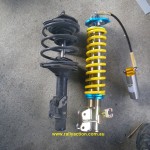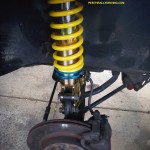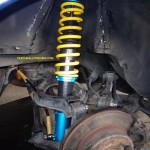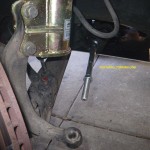180SX Brakes & Suspension
The most crucial part of any Rally car build, Brakes & Suspension.
Most people think that the focus of a competition car should be on the engine to produce more power and then the drive train to take the extra power from the engine. It’s a classic mistake.
The primary focus should be on the brakes and suspension. Get the most out of the available power you have, then worry about more power later.
For the 180SX Rally Car, we opted to use STD gravel suspension. Sometime in the near future we’ll create a video and/or pod cast review of STD gravel suspension. For the time being, let’s just say that on paper the specs looked good and the price was considerably less than the other established brands of Gravel suspension available in Australia. We opted for the STD 50mm, remote canister units, reasoning that we’d fit the largest suspension we could into the car. This is the first set of Gravel suspension STD have made for a S13, so we’re also providing feedback to the factory for development.
review of STD gravel suspension. For the time being, let’s just say that on paper the specs looked good and the price was considerably less than the other established brands of Gravel suspension available in Australia. We opted for the STD 50mm, remote canister units, reasoning that we’d fit the largest suspension we could into the car. This is the first set of Gravel suspension STD have made for a S13, so we’re also providing feedback to the factory for development.
The S13’s use a simple damper set up front and rear which is fairly quick and easy to remove and fit. We’d already removed the rear dampers during the build and the standard front struts were out on the ground in a few minutes.
 We then sized up the new STD units and set about bolting them into place. The hardest part of the whole operation was deciding where to position the remote canisters. In the engine bay, the canisters were tucked neatly into the corners up by the firewall.
We then sized up the new STD units and set about bolting them into place. The hardest part of the whole operation was deciding where to position the remote canisters. In the engine bay, the canisters were tucked neatly into the corners up by the firewall.
In the rear, it was a little trickier. The rear suspension use an inverted damper and therefore the remote canister is at the bottom of the damper instead of the top. We had to think carefully about where to mount the canister. Anywhere on the suspension arms would place the canister at a risk of damage. Besides, the rotating drive shafts could become a problem if the canister came loose for any reason. After some thinking and trial positions, we found the canisters would tuck up neatly behind the rear sub frame on both sides of the car, just in front of the fuel tank. This is the best location to keep the canisters out of harm’s way.
would place the canister at a risk of damage. Besides, the rotating drive shafts could become a problem if the canister came loose for any reason. After some thinking and trial positions, we found the canisters would tuck up neatly behind the rear sub frame on both sides of the car, just in front of the fuel tank. This is the best location to keep the canisters out of harm’s way.
With the suspension fitted, we then removed the standard S13 tie rod ends and “tooth pick” steering rack end arms (front end only, no HICAS on this car). In their place, thicker and stronger end arms were fitted with R33 Skyline tie rod ends. In the future we may move to rose jointed arms and caster bars, however for the time being, budget and time meant keeping everything as simple as possible.
Whilst the wheels were off the car, we also replaced all the brake pads. Up front, a set of Ferodo DS3000 pads found their way into the callipers. Having retained the standard single pot rear callipers, we chose to use a semi metallic road pad, rather than an out and out race pad. One of the first development items on our list after the first rally is to upgrade the rear brakes to the z32 rear callipers which will mean a change of brake pads anyway.
During brake pad replacement we also discovered a leaky front bleed nipple on the right side and cacked seals in the left rear calliper. Both items were replaced with good spare units and the brakes were re-bled.
Under body protection and mud flaps were tackled in quick succession as the last items before the car was lowered to the ground. Over the years we have used several different types of material for under body protection. Up until now, we have mainly used moulded Kevlar/Carbon fibre sections that are fixed to the under body and sills of rally cars. This method is expensive and the maintenance even on Kevlar is pretty high. On the 180SX, we used HDPE sheet for under body protection instead. This is very tough material and will withstand a huge amount of battering with little wear. Having retained the factory fuel tank, a HDPE sheet was cut and slipped between the factory fuel tank brackets and the tank to make a quick and effective fuel tank guard.
Initial mud flaps were cut from traditional urethane sheet, however with HDPE being much cheaper, we will cut spare mud flaps from HDPE and trial them for future use instead of the more expensive urethane.
A used set of rally tyres were rolled onto a set of standard S13 15″ wheels for the upcoming khanacross. (15″ tyres are the largest available for gravel rally) A temp spot light bracket and two lights were also fitted for the night sections of the Khanacross.
The car was finally dropped onto its wheels and test driven, the first time the car had moved under its own power in nearly 3 months. Apart from bedding in the new brake pads, everything was fine. The car ran well, stopped, turned and boosted (deliberately wound back from 16PSI to around 10PSI) as it should.
As we neared the car’s competition debut at a Twilight Khanacross (click here to see the video), we also organised for the all important Log book inspection to have the car certified for Rally competition. It all went smoothly and the paperwork was lodged with CAMS.
More build articles here
Next post will cover the car’s first event, some minor development and the Quit Forest Rally.
